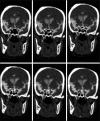Endoscopic management of cerebrospinal fluid rhinorrhea
- PMID: 27366243
- PMCID: PMC4849285
- DOI: 10.4103/1793-5482.145101
Endoscopic management of cerebrospinal fluid rhinorrhea
Abstract
Cerebrospinal fluid (CSF) rhinorrhea occurs due to communication between the intracranial subarachnoid space and the sinonasal mucosa. It could be due to trauma, raised intracranial pressure (ICP), tumors, erosive diseases, and congenital skull defects. Some leaks could be spontaneous without any specific etiology. The potential leak sites include the cribriform plate, ethmoid, sphenoid, and frontal sinus. Glucose estimation, although non-specific, is the most popular and readily available method of diagnosis. Glucose concentration of > 30 mg/dl without any blood contamination strongly suggests presence and the absence of glucose rules out CSF in the fluid. Beta-2 transferrin test confirms the diagnosis. High-resolution computed tomography and magnetic resonance cisternography are complementary to each other and are the investigation of choice. Surgical intervention is indicated, when conservative management fails to prevent risk of meningitis. Endoscopic closure has revolutionized the management of CSF rhinorrhea due to its less morbidity and better closure rate. It is usually best suited for small defects in cribriform plate, sphenoid, and ethmoid sinus. Large defects can be repaired when sufficient experience is acquired. Most frontal sinus leaks, although difficult, can be successfully closed by modified Lothrop procedure. Factors associated with increased recurrences are middle age, obese female, raised ICP, diabetes mellitus, lateral sphenoid leaks, superior and lateral extension in frontal sinus, multiple leaks, and extensive skull base defects. Appropriate treatment for raised ICP, in addition to proper repair, should be done to prevent recurrence. Long follow-up is required before leveling successful repair as recurrences may occur very late.
Keywords: Cerebrospinal fluid pressure; cerebrospinal fluid; cerebrospinal fluid rhinorrhea; endoscopic surgical procedure; skull base.
Conflict of interest statement
Figures






Similar articles
-
The Endonasal Endoscopic Management of Cerebrospinal Fluid Rhinorrhea.Cureus. 2021 Feb 20;13(2):e13457. doi: 10.7759/cureus.13457. Cureus. 2021. PMID: 33777546 Free PMC article.
-
Spontaneous cerebrospinal fluid leaks in the anterior skull base secondary to idiopathic intracranial hypertension.Eur Arch Otorhinolaryngol. 2017 May;274(5):2175-2181. doi: 10.1007/s00405-017-4455-5. Epub 2017 Feb 7. Eur Arch Otorhinolaryngol. 2017. PMID: 28175991
-
Venous Sinus Stenting in the Management of Patients with Intracranial Hypertension Manifesting with Skull Base Cerebrospinal Fluid Leaks.World Neurosurg. 2017 Oct;106:103-112. doi: 10.1016/j.wneu.2017.06.087. Epub 2017 Jun 20. World Neurosurg. 2017. PMID: 28645586
-
Spontaneous cerebrospinal fluid leak and management of intracranial pressure.Adv Otorhinolaryngol. 2013;74:92-103. doi: 10.1159/000342284. Epub 2012 Dec 18. Adv Otorhinolaryngol. 2013. PMID: 23257556 Review.
-
[Spontaneous cerebrospinal rhinorrhea. Etiology--differential diagnosis--therapy].HNO. 1991 Jan;39(1):1-7. HNO. 1991. PMID: 2030080 Review. German.
Cited by
-
Management of recurrent cerebrospinal fluid leak, current practices and open challenges. A systematic literature review.Acta Otorhinolaryngol Ital. 2023 Apr;43(Suppl 1):S14-S27. doi: 10.14639/0392-100X-suppl.1-43-2023-02. Acta Otorhinolaryngol Ital. 2023. PMID: 37698096 Free PMC article. Review.
-
Closure of spontaneous cerebrospinal fluid leakage via fistula at the lateral wall of the sphenoid sinus using a bone pile.Clin Case Rep. 2022 Mar 3;10(3):e05510. doi: 10.1002/ccr3.5510. eCollection 2022 Mar. Clin Case Rep. 2022. PMID: 35280093 Free PMC article.
-
Spontaneous Cerebrospinal Fluid Rhinorrhea in End Stage Renal Disease.Indian J Nephrol. 2021 May-Jun;31(3):296-298. doi: 10.4103/ijn.IJN_372_19. Epub 2021 Mar 27. Indian J Nephrol. 2021. PMID: 34376948 Free PMC article.
-
Fluoroscein toxicity - Rare but dangerous.Indian J Anaesth. 2019 Aug;63(8):674-675. doi: 10.4103/ija.IJA_164_19. Indian J Anaesth. 2019. PMID: 31462817 Free PMC article. No abstract available.
-
Delayed Pneumoventricle Following Endonasal Cerebrospinal Fluid Rhinorrhea Repair with Thecoperitoneal Shunt.Asian J Neurosurg. 2019 Jan-Mar;14(1):325-328. doi: 10.4103/ajns.AJNS_224_18. Asian J Neurosurg. 2019. PMID: 30937067 Free PMC article.
References
-
- Yadav YR, Shenoy R, Mukerji G, Parihar V. Water jet dissection technique for endoscopic third ventriculostomy minimises the risk of bleeding and neurological complications in obstructive hydrocephalus with a thick and opaque third ventricle floor. Minim Invasive Neurosurg. 2010;53:155–8. - PubMed
-
- Yadav YR, Parihar V, Sinha M, Jain N. Endoscopic treatment of supra sellar arachnoid cyst. Neurol India. 2010;58:280–83. - PubMed
-
- Landeiro JA, Lázaro B, Melo MH. Endonasal endoscopicrepair of cerebrospinal fluid rhinorrhea. Minim Invasive Neurosurg. 2004;47:173–7. - PubMed
-
- Yadav YR, Parihar V, Agarwal M, Sherekar S, Bhatele PR. Endoscopic vascular decompression of the trigeminal nerve. Minim Invasive Neurosurg. 2011;54:110–4. - PubMed
-
- Yadav YR, Yadav S, Sherekar S, Parihar V. A new minimally invasive tubular brain retractor system for surgery of deep intracerebral hematoma. Neurol India. 2011;59:74–7. - PubMed
Publication types
LinkOut - more resources
Full Text Sources
Other Literature Sources

